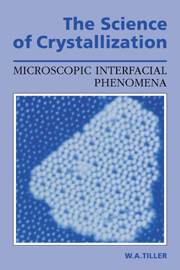Book contents
1 - Introduction and philosophy
Published online by Cambridge University Press: 13 February 2010
Summary
We have all been delighted and fascinated by the variety of crystal forms that abound in nature and please the eye. Each pattern in this vast panorama appears unique. The variations seen in the growth forms presented in Fig. 1.1 give us some idea of how the dendritic growth form can change in appearance as we change from material to material or from one crystal growth process to another. Even for a single material and a single process we often find great variability as illustrated by Nakaya's eight common snow-flake patterns given in Fig 1.2. Such variability and uniqueness of form caused earlier scientists to speculate on and argue about the relative importance of heredity factors versus environment factors in the ultimate form of such crystals.
A relatively recent experiment by Mason tended to illuminate this issue and strongly favor the environmental factor control point of view. He placed a nylon fiber in the water vapor diffusion chamber illustrated in Fig. 1.3 and observed the form of the ice crystals that developed at the different temperature locations along the fiber. This great range of forms is listed in Table 1.1. After these forms were growing stably in the chamber, he lifted the fiber some distance so that those crystals growing between temperatures T1 and T2 on the fiber were shifted to another temperature range T3 - T4 characteristic of a different crystal form on the earlier result.
- Type
- Chapter
- Information
- The Science of CrystallizationMicroscopic Interfacial Phenomena, pp. 1 - 36Publisher: Cambridge University PressPrint publication year: 1991

